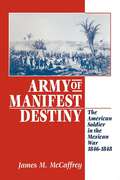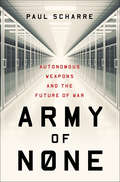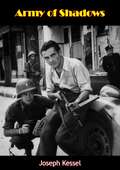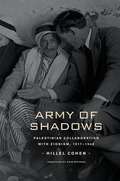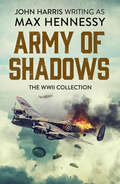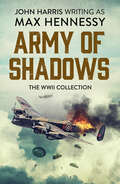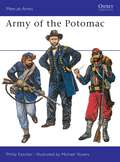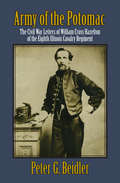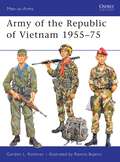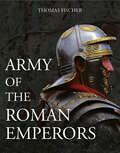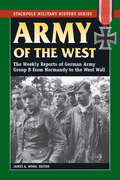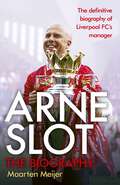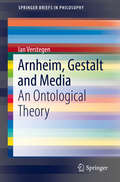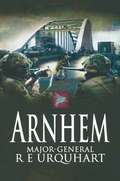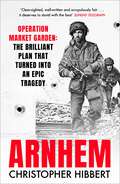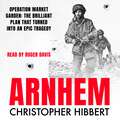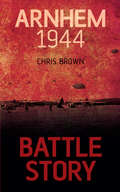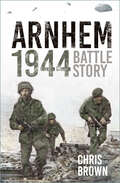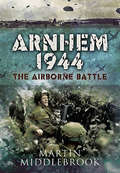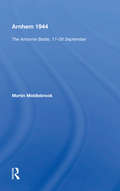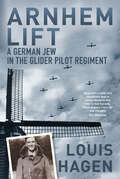- Table View
- List View
Army of Manifest Destiny: The American Soldier in the Mexican War, 1846-1848 (The American Social Experience #11)
by James M. MccaffreyThe day-to-day experiences of the American soldiers fighting in the Mexican WarJames McCaffrey examines America's first foreign war, the Mexican War, through the day-to-day experiences of the American soldier in battle, in camp, and on the march. With remarkable sympathy, humor, and grace, the author fills in the historical gaps of one war while rising issues now found to be strikingly relevant to this nation's modern military concerns.
Army of None: Autonomous Weapons And The Future Of War
by Paul ScharreA Pentagon defense expert and former U.S. Army Ranger explores what it would mean to give machines authority over the ultimate decision of life or death. <P><P> What happens when a Predator drone has as much autonomy as a Google car? Or when a weapon that can hunt its own targets is hacked? Although it sounds like science fiction, the technology already exists to create weapons that can attack targets without human input. Paul Scharre, a leading expert in emerging weapons technologies, draws on deep research and firsthand experience to explore how these next-generation weapons are changing warfare. <P><P> Scharre’s far-ranging investigation examines the emergence of autonomous weapons, the movement to ban them, and the legal and ethical issues surrounding their use. He spotlights artificial intelligence in military technology, spanning decades of innovation from German noise-seeking Wren torpedoes in World War II—antecedents of today’s homing missiles—to autonomous cyber weapons, submarine-hunting robot ships, and robot tank armies. Through interviews with defense experts, ethicists, psychologists, and activists, Scharre surveys what challenges might face "centaur warfighters" on future battlefields, which will combine human and machine cognition. We’ve made tremendous technological progress in the past few decades, but we have also glimpsed the terrifying mishaps that can result from complex automated systems—such as when advanced F-22 fighter jets experienced a computer meltdown the first time they flew over the International Date Line. <P><P>At least thirty countries already have defensive autonomous weapons that operate under human supervision. Around the globe, militaries are racing to build robotic weapons with increasing autonomy. The ethical questions within this book grow more pressing each day. To what extent should such technologies be advanced? And if responsible democracies ban them, would that stop rogue regimes from taking advantage? At the forefront of a game-changing debate, Army of None engages military history, global policy, and cutting-edge science to argue that we must embrace technology where it can make war more precise and humane, but without surrendering human judgment. When the choice is life or death, there is no replacement for the human heart.
Army of Shadows
by Joseph Kessel Haakon ChevalierTHIS IS THE TRUTH, THOUGH THE FORM IS FICTION…The terrible and inspiring truth about the French underground, the way it’s men and women operate, fight, die, a story full of nobility, heroism, and brutal violence.First published in its English translation in 1944, this is the fictionalized account of French writer Joseph Kessel’s own experiences as a member of the French Resistance in World War II.
Army of Shadows: Palestinian Collaboration with Zionism, 1917-1948
by Haim Watzman Hillel CohenInspired by stories he heard in the West Bank as a child, Hillel Cohen uncovers a hidden history in this book--a history central to the narrative of the Israel-Palestine conflict but for the most part willfully ignored until now. In Army of Shadows, he tells the story of Arabs who, from the very beginning of the Arab-Israeli encounter, sided with the Zionists and aided them politically, economically, and in security matters.
Army of Shadows: The WWII Collection
by Max HennessyGetting shot down is just the beginning in this epic story of survival and resistance in a country crawling with Nazi soldiers during the Second World War. They fought without glory—and without mercy. France, Winter 1944: The long-awaited liberation is at hand. The bombing missions had gone well, and the crew of the Lancaster bomber had begun to relax. Then the Messerschmitt came out of the darkness, its guns blazing. Of the nine-man crew only Neville and Urquhart survive, parachuting into the heart of occupied France. Joining forces with the men of the French Resistance, they must enter a deadly game of cat and mouse with a ruthless enemy . . . A nerve-shredding thriller of the Second World War, steeped in historical research, perfect for fans of Alistair MacLean, Jack Higgins, and Wilbur Smith.
Army of Shadows: The WWII Collection
by Max HennessyThey fought without glory – and without mercy.France, Winter 1944: The long-awaited liberation is at handThe bombing missions had gone well, and the crew of the Lancaster bomber had begun to relax. Then the Messerschmitt came out of the darkness, its guns blazing.Of the nine-man crew only Neville and Urqhart survive, parachuting into the heart of occupied France. Joining forces with the men of the French Resistance, they must enter a deadly game of cat and mouse with a ruthless enemy...A nerve-shredding thriller of the Second World War, steeped in historical research, perfect for fans of Alistair MacLean, Jack Higgins and Wilbur Smith.
Army of the Potomac
by Michael Youens Philip KatcherFor General George B. McClellan, the dejected Union troops who poured into Washington fresh from defeat at Bull Run on Monday, July 22, 1861, were to provide the raw material which he would train, equip, organize and ultimately transform from a mere mob into an effective fighting force. In October 1861, the Army of the Potomac officially came into being. This entertaining volume from the same team of author Philip Katcher and artist Michael Youens who produced Men-at-Arms 37, The Army of Northern Virginia, explores how this transition came about, with a particular emphasis on weapons, uniforms and equipment.
Army of the Potomac: McClellan's First Campaign, March 1862–May 1862
by Russel H. BeatieThe third volume of this masterful Civil War history series covers the pivotal early months of General George McClellan&’s Peninsula Campaign. As he did in his first two volumes of this magisterial series, Russel Beatie tells the story largely through the eyes and from the perspective of high-ranking officers, staff officers, and politicians. This study is based upon extensive firsthand research (including many previously unused and unpublished sources) that rewrites the history of Little Mac&’s inaugural effort to push his way up the peninsula and capture Richmond in one bold campaign. In meticulous fashion, Beatie examines many heretofore unknown, ignored, or misunderstood facts and events and uses them to evaluate the campaign in the most balanced historical context to date. Every aspect of these critically important weeks is examined, from how McClellan&’s Urbanna plan unraveled and led to the birth of the expedition that debarked at Fort Monroe in March 1862, to the aftermath of Williamsburg. To capture the full flavor of their experiences, Beatie employs the &“fog of war&” technique, which puts the reader in the position of the men who led the Union army. The Confederate adversaries are always present but often only in shadowy forms that achieve firm reality only when we meet them face-to-face on the battlefield. Well written, judiciously reasoned, and extensively footnoted, McClellan&’s First Campaign will be heralded as the seminal work on this topic. Civil War readers may not always agree with Beatie&’s conclusions, but they will concur that his account offers an original examination of the Army of the Potomac&’s role on the Virginia peninsula. &“If you want to understand the war in the east, this series is essential.&” —Civil War Books and Authors
Army of the Potomac: The Civil War Letters of William Cross Hazelton of the Eighth Illinois Cavalry Regiment
by Peter G. BeidlerA riveting, on-the-ground account of the American Civil War by a Union cavalryman who survived most of the historic conflict’s biggest battles. William Cross Hazelton spent four years in the Civil War as a brave and devoted member of the Union cavalry. During that time he corresponded with Fannie Morrill, the young woman who would become his wife. His letters describe the life of an Illinois volunteer in the Army of the Potomac, the military unit that fought Lee’s Army of Northern Virginia in most of the big battles of the Civil War: Williamsburg, Richmond, Antietam, Fredericksburg, Chancellorsville, and Gettysburg. Hazelton describes the battles from the viewpoint of an ordinary cavalryman slogging through the mud, following erratic orders, surviving for days on enemy turf eating nothing but hardtack, and wondering why the Union army, though superior in numbers and supplies, kept losing battles. Later, when Lincoln was assassinated, Hazelton became part of the cavalry posse that chased John Wilkes Booth across the Potomac. His letters breathe new life into a war so devastating that it still scars the American psyche, while exhibiting a moral perspective far ahead of its time. Army of the Potomac is an essential, eye-opening account of one of America’s most harrowing epochs, and was a finalist in the 2013 Next Generation Indie Book Awards.
Army of the Republic of Vietnam 1955-75
by Ramiro Bujeiro Gordon RottmanRottman's latest title discusses the original reorganization of Vietnam forces, from the original colonial structure implemented by the French into the first national army of Vietnam. Complete with a detailed history of the command structure and orders of battle, Rottman sheds light on the little known divisional histories of the army through rare, original source material. Moreover, the author examines in detail the evolution of such key units as armoured forces, ranger commands as well as combat unit organization. This, together with a detailed analysis of the experiences of the typical rank and file soldier as well as officer corps, provides a concise and and in-depth history of an army that is too often neglected or quickly judged.
Army of the Roman Emperors: Archaeology And History
by Thomas FischerAn illustrated history exploring the Imperial Roman army&’s many facets, including uniforms, weapons, buildings, and their duties. Compared to modern standard, the Roman army of the Imperial era was surprisingly small. However, when assessed in terms of their various tasks, they by far outstrip modern armies—acting not only as an armed power of the state in external and internal conflicts, but also carrying out functions nowadays performed by police, local government, customs, and tax authorities, as well as constructing roads, ships, and buildings. With this volume, Thomas Fischer presents a comprehensive and unique exploration of the Roman military of the Imperial era. With over 600 illustrations, the costumes, weapons and equipment of the Roman army are explored in detail using archaeological finds dating from the late Republic to Late Antiquity, and from all over the Roman Empire. The army&’s buildings and fortifications are also featured. Finally, conflicts, border security, weaponry, and artifacts are all compared, offering a look at the development of the army through time. This work is intended for experts as well as to readers with a general interest in Roman history. It is also a treasure-trove for re-enactment groups, as it puts many common perceptions of the weaponry, equipment, and dress of the Roman army to the test.
Army of the West (Stackpole Military History Series)
• Essential primary source on the German defense of Western Europe in World War II• Concise chapter introductions provide historical context for the reportsIn May 1944 German Army Group B, headquartered in France, requested weekly reports from its commanders. These accounts included assessments of the general situation, estimates of the Allies' situation, casualty figures, equipment losses, and descriptions of resistance activities. Commanded successively by Erwin Rommel, Günther von Kluge, and Walter Model, Army Group B bore the brunt of the Allied assault--D-Day, the Normandy campaign, and Operation Market-Garden--and these reports reveal what the German Army was thinking as it confronted the invasion.
Arne Slot: The definitive first biography of the new Liverpool FC manager
by Maarten MeijerArne Slot: The Biography is the definitive portrait of the Dutch manager who took on one of the toughest jobs in football – succeeding Jürgen Klopp – and delivered a Premier League triumph in his first season at Liverpool FC. Slot had proven himself in the Netherlands – leading AZ Alkmaar to a second-place finish and delivering Feyenoord their first title in six years. With a bold, high-pressing style and sharp mind, he had earned a reputation as one of Europe’s brightest managerial prospects.When Klopp’s era ended in 2024, Anfield held its breath. But Slot stepped into the void with calm authority and tactical brilliance. By Christmas, Liverpool were top of both the Premier League and Champions League tables, having lost just once. Key players like Mohamed Salah, Virgil van Dijk, Ryan Gravenberch, Alexis Mac Allister and Dominik Szoboszlai found renewed form under his leadership. Slot ushered in a new era of confidence and cohesion at Anfield.In this richly detailed biography, acclaimed Dutch author Maarten Meijer traces Slot’s journey from the quiet village of Bergentheim to the Premier League summit. He unpacks the methods, mentality and rise of a coach who has already lifted his first major English trophy and whose vision and leadership are reshaping Liverpool’s future.
Arnheim, Gestalt and Media: An Ontological Theory (SpringerBriefs in Philosophy)
by Ian VerstegenThis monograph presents a synthesis and reconstruction of Rudolf Arnheim’s theory of media. Combining both Arnheim’s well-known writings on film and radio with his later work on the psychology of art, the author presents a coherent approach to the problem of the nature of a medium, space and time, and the differentia between different media. The latent ontological commitments of Arnheim’s theories is drawn out by affirming Arnheim’s membership in the Brentano school of Austrian philosophy, which allows his theories to be clarified and strengthened, particularly with the metaphysical writings of Roman Ingarden. The resulting theory is relational, portraying essential medial differences with neutral criteria and allowing for a rigorous definition of a medium. The way in which a medium is based on the inherent dispositions of medial materials creates a highly appealing theory that is determinate without being deterministic. The theory is thus highly timely as people in media studies seek to address the determinate nature of media after the post-medium condition. The book will appeal to researchers and graduate students in cultural and media studies as well as architecture and design.
Arnhem
by R. E. UrquhartAn on-the-ground account of the 1st Airborne Division during Operation Market Garden from the British commander who led the &“Bridge Too Far&” battle. Major-General Urquhart commanded the 1st British Airborne Division in Operation Market Garden, the greatest airborne assault of World War II, the struggle to capture Arnhem and win control of the bridge across the lower Rhine. The story of the 1st Airborne Division at Arnhem involved not only an Airborne Corps of three Divisions but also the bulk of the British 2nd Army in Europe. Gen. Urquhart has told the story of those fateful nine days clearly, frankly and, despite the terrible circumstances, not without humor. It ranks as an important work, describing an operation which opened with such high hopes and left its name forever as a feat of the highest endurance and valor.
Arnhem (GREAT BATTLES)
by Christopher HibbertThe vivid account of how a brilliant plan turned into an epic tragedy - made into the BAFTA award-winning film A BRIDGE TOO FAR'Alive with the detail that evokes the smoking background' DAILY TELEGRAPH'Finely recorded...truly the battle of Arnhem has been fortunate in its historian' SUNDAY TIMESThis book tells the true story of the Battle of Arnhem which was fought in September 1944. Nine thousand men of the First British Airborne Division were parachuted into the peaceful countryside that surrounded Arnhem. Their objective was to capture and hold the bridge over the Rhine ahead of the advancing British Second Army. Nine days later, after some of the fiercest street-fighting of the war, 2000 paratroopers managed to escape to safety.Made famous by the film A BRIDGE TOO FAR
Arnhem (GREAT BATTLES)
by Christopher HibbertThe vivid account of how a brilliant plan turned into an epic tragedy - made into the BAFTA award-winning film A BRIDGE TOO FAR'Alive with the detail that evokes the smoking background' DAILY TELEGRAPH'Finely recorded...truly the battle of Arnhem has been fortunate in its historian' SUNDAY TIMESThis book tells the true story of the Battle of Arnhem which was fought in September 1944. Nine thousand men of the First British Airborne Division were parachuted into the peaceful countryside that surrounded Arnhem. Their objective was to capture and hold the bridge over the Rhine ahead of the advancing British Second Army. Nine days later, after some of the fiercest street-fighting of the war, 2000 paratroopers managed to escape to safety.Made famous by the film A BRIDGE TOO FAR
Arnhem (GREAT BATTLES)
by Christopher HibbertThe vivid account of how a brilliant plan turned into an epic tragedy - made into the BAFTA award-winning film A BRIDGE TOO FAR'Alive with the detail that evokes the smoking background' DAILY TELEGRAPH'Finely recorded...truly the battle of Arnhem has been fortunate in its historian' SUNDAY TIMESThis book tells the true story of the Battle of Arnhem which was fought in September 1944. Nine thousand men of the First British Airborne Division were parachuted into the peaceful countryside that surrounded Arnhem. Their objective was to capture and hold the bridge over the Rhine ahead of the advancing British Second Army. Nine days later, after some of the fiercest street-fighting of the war, 2000 paratroopers managed to escape to safety.Made famous by the film A BRIDGE TOO FAR
Arnhem 1944
by Chris BrownThe Battle of Arnhem is one of the most iconic Western front battles of the Second World War. When we think of Arnhem, we think of a bridge too far and a sky full of parachutes dropping the Allies into the Netherlands. It was one of the most complex and strategically important operations of the war. Operation Market Garden was devised to give the Allies the opportunity to bypass the German Siegfried Line and attack the Ruhr. Paratroopers were dropped into the Netherlands to secure all the bridgeheads and major routes along the proposed Allied axis advance. Simultaneously, the 1st Airborne Division, supported by the Glider Pilot Regiment and Polish 1st Independent Parachute Brigade, landed at Arnhem. The British expected to sweep through and connect with the Arnhem force within a matter of days. However, things on the ground proved very different. The troops met resistance from pockets of SS soldiers and soon were overwhelmed. The Arnhem contingent was cut off from reinforcement and eventually forced to withdraw. The 1st Airborne Division lost three-quarters of its strength in the operation and did not see battle again. Through quotes and maps, the text explores the unfolding action of the battle and puts the reader on the frontline. If you truly want to understand what happened and why — read the Battle Story.
Arnhem 1944: Arnhem 1944 (Battleground General Ser.)
by Diane Canwell Jon SutherlandThis is the first in a series of game books which put you in command of the forces in engaged in some of history's most famous battles. Your tactical skill and ability to make the right command decision will be tested at every turn of the page. Operation Market Garden in September 1944 was one of the most daring Allied plans of the Second World War. An audacious surprise assault from the air, it was intended to give the Allies a bridgehead across the Rhine, removing the last significant natural barrier on the road to Berlin. If successful it might have shortened the war by months. Will the brave British paratroopers be able to seize the vital bridge at Arnhem and hold it until reinforcements fight their way through? Or will the Germans be able to recover the initiative and crush them in a skillful counterattack? The book presents you with a series of command decisions, aided by situation maps; directing you to the next relevant briefing depending on the option you choose. No dice are necessary to play, just this book and your tactical skill. When you buy this book, the fate of nations is in your hands.
Arnhem 1944: Battle Story
by Chris BrownThe Battle of Arnhem has acquired a near-legendary status in British military history as an audacious plan to land paratroopers into the Netherlands and spearhead an attack against the German-held Ruhr. Beyond images of brave paratroopers and scenes from A Bridge Too Far, this was in fact one of the most complex and strategically important operations of the war.It was expected that the British would sweep through and connect with the Arnhem force within a matter of days. But things on the ground proved very different. The Allied forces were isolated, without reinforcements and unable to advance. The operation ended in disaster. Using first-hand accounts, maps and detailed timelines, historian Chris Brown explores the unfolding action of the battle and puts the reader on the front line. If you truly want to understand what happened and why – read on.
Arnhem 1944: The Airborne Battle
by Martin MiddlebrookA detailed history of the World War II battle, featuring experiences from over 500 participants, by the author of The First Day on the Somme. The Battle of Arnhem was a turning point in the war, a gamble by Montgomery, using three airborne divisions to capture a series of bridges spanning the wide rivers of Holland and unleash the Allied armies into the plains of northern Germany. If the bridges had been captured and held, and the ground forces had been able to relieve the airborne forces, then there would have been a good chance of ending the war before Christmas, 1944. It all went wrong. Although the bridges taken by the Americans were relieved by ground troops, these troops could not reach Arnhem quickly enough. In the meantime, only a small part of the 1st British Airborne Division had reached the Arnhem Bridge. Most of the remainder of the airborne force was held up on the outskirts of the town by German units that turned out to be far stronger than expected—a major intelligence failure. After nine days of fighting, the survivors of the division were withdrawn across the Rhine, and it was not until many months later that ground forces captured Arnhem. Using the technique he has perfected over twenty-five years of military study, blending meticulous research based on original documents with the personal experiences of more than 500 participants, Martin Middlebrook describes the Battle of Arnhem from start to finish, from one end of that complicated battlefield to the other. He offers a masterly summary of what went wrong in the last major defeat in battle suffered by the British Army.
Arnhem 1944: The Airborne Battle (Stackpole Military History Ser.)
by Martin MiddlebrookArnhem - it was the last major battle lost by the British Army, lost not by the men who fought there but by the overconfidence of generals, faulty planning and the failure of a relieving force given too great a task. If the operation of which Arnhem formed a part had been successful, the outcome of the war and the history of post-war Europe would have been greatly altered. Yet is it worth another book? I had fulfilled all my literary ambitions by researching and writing thirteen full-length books and was ready to retire from that laborious craft when Peter van Gorsel, head of Penguin's Dutch office, asked me to write a book on Arnhem for the fiftieth anniversary in 1994. It was the first time that my publishers had requested a book; all previous subjects had been my choice. I eventually agreed for several reasons. I had not previously researched and written about the British Army in the Second World War and had not previously done any work in Holland; so two fresh fields were opened up to me. I also felt that the fighting in and around Arnhem had still not been described in the detail that it merited.
Arnhem 1944: The Human Tragedy of the Bridge Too Far
by Dilip SarkarThe airborne battle for the bridges across the Rhine at Arnhem ranks amongst the Second World Wars most famous actions inspiring innumerable books and the star-studded 1977 movie. This book, however, is unique: deeply moved, the author provides a fresh narrative and approach concentrating on the tragic stories of individual casualties.These men were killed at different junctures in the fighting, often requiring forensic analysis to ascertain their fates. Wider events contextualize the authors primary focus - effectively resurrecting casualties through describing their backgrounds, previous experience, and tragic effect on their families. In particular, the emotive and unresolved issue of the many still missing is explored.During the course of his research, the author made numerous trips to Arnhem and Oosterbeek, traveled miles around the UK, and spent countless hours communicating with the relatives of casualties achieving their enthusiastic support. This detailed work, conducted sensitively and with dignity, ensures that these moving stories are now recorded for posterity.Included are the stories of Private Albert Willingham, who sacrificed his life to save civilians; Major Frank Tate, machine-gunned against the backdrop of blazing buildings around Arnhem Bridge; family man Sergeant George Thomas, whose antitank gun is displayed today outside the Airborne Museum Hartenstein, and Squadron Leader John Gilliard DFC, father of a baby son who perished flying his Stirling through a hail of shot and shell during an essential re-supply drop. Is Private Gilbert Anderson, who remains missing, actually buried as an unknown, the author asks? Representing the Poles is Lance-Corporal Czeslaw Gajewnik, who drowned whilst escaping the hell of Oosterbeek, and accounts by Dutch civilians emphasize the shared suffering sharply focussed by the tragedy of Luuk Buist, killed protecting his family. The sensitivity still surrounding German casualties is also explained.This raw, personal, side of war, the hopes and fears of ordinary men thrust into extraordinary circumstances, is both deeply moving and revealing: no longer are these just names carved on headstones or memorials in a distant land. Through this thorough investigative work, supported by those who remember them, the casualties live again, their silent voices heard through friends, relatives, comrades and unpublished letters.So, let us return to the fateful autumn of 1944, and meet those fighting in the skies, on the landing grounds, in the streets and woods of Oosterbeek, and on the bridge too far at Arnhem.Now, the casualties can tell their own stories as we join this remarkable journey of discovery.
Arnhem Lift: A German Jew in the Glider Pilot Regiment
by Louis HagenOf the 10,000 men who landed at Arnhem, over nine days 1,400 were killed and more than 6,000 – about a third of them wounded – were captured. It was a bloody disaster. The remarkable Louis Hagen, an ‘enemy alien’ who had escaped to England having been imprisoned and tortured in a Nazi concentration camp as a boy just a few years earlier, was one of the minority who made it back. What makes this book so unforgettable is not only the breathtaking drama of the story itself, it is the unmistakable talent of the writer. The narrative was first published anonymously in 1945.45 years later at a dinner party in Germany, Louis Hagen met Major Winrich Behr, Adjutant to Field Marshal Model at Arnhem. Louis added his side of the story to add even more insight to the original work.
